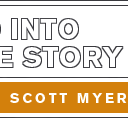Writing and the Creative Life: Boundaries of Space, Boundaries of Time
We all know John Cleese from his work with Monty Python’s Flying Circus and Fawlty Towers, but he has also emerged as something of an authority on creativity. Here is an excerpt from a presentation he gave in Belgium some years ago:
Here is a transcript of the main part of his talk:
People often say, Where do you get your ideas from? And I say I get them from a Mr. Ken Levingshore who lives in Swinden, he sends them to me every Monday morning on a postcard. I once asked Ken where he gets his ideas from, and he gets them from a lady called Mildred Spong who lives on the Isle of Wight. He once asked Mildred where she gets her ideas from and she refused to say. So the point is, we don’t know. This is terribly important. We don’t know where we get our ideas from. What we do know is we do not get them from our laptops.
In fact, we get our ideas from what I’m going to call for the moment, our unconscious, the part of our mind that goes on working, for example, when we’re asleep.
What I’m saying is, if you get into the right mood, then your mode of thinking will become much more creative. If you’re racing around all day, ticking things off on lists, checking your watch, making phone calls, and generally keeping all the balls in the air, you are not going to have any creative ideas.
So now I want to run over how in this very frenzied world we all live in, how you may create a mood that will enable you to be more creative. Basically the way I put it is you need to create a tortoise enclosure. So that your little tortoise mind, a little nervous creature, can look around, and say, Yes, it’s safe to come out.
To do this, you have to create a kind of oasis in your life. In the middle of the stressed, Oh, I’ve forgotten to do this, I’ve got to do that, I have to be there by eleven… in the middle of all that, you have to create an oasis. A tortoise enclosure where your tortoise mind can come out to play.
There’s two things you have to do. You have to create boundaries of space, and you have to create boundaries of time. It’s as simple as that.
Boundaries of space so you can avoid interruptions which is disastrous to the creative process… then you have to give yourself a starting time and a finish time. Because when you do that, you have created an oasis which is separate from ordinary life, and then and only then can you play.
Truth in these words, yes? And so simple… in theory! Boundaries of space. Boundaries of time. But there’s this damn thing called life which keeps getting in the way. So two words to help underscore the main point Cleese makes.
Intentionality: In order to create boundaries of space and time, we have to be intentional. We must confront the energy of life coming at us, thrust up our hands, dig in our heels, and yell, “STOP! For the next x amount of minutes, I am going to be over here. Respect my boundaries, respect my time, respect my needs because I intend to use this chunk of my day to be creative.” Be intentional.
Sacred: I like the idea of an oasis, but what caught my attention is the idea of “separate from ordinary life.” When I heard that, I was suddenly jolted back to my days at Yale Divinity School and in particular a course I took called Christianity and the Arts. In that class, we studied all sorts of religious iconography as well as remarkable worship environments like this one:

That is the interior of the Chartres Cathedral, the epitome of what we may call a sacred space. Throughout history, members of religions from all around the world have built edifices such as this as a way of creating a place into which they can go to separate themselves from the ordinary world and allow their spiritual nature to emerge.
What if in the face of our hectic lives, we claimed our creative time to be our own ‘sacred space’? In doing so, we separate ourselves from the clutter and noise of the ordinary world, and embrace the quietude and solitude of the extraordinary world… where our creativity can come out to play.
Writing and the Creative Life is a weekly series in which we explore creativity from the practical to the psychological, the latest in brain science to a spiritual take on the subject. Hopefully the more we understand about our creative self, the better we will become as writers. If you have any good reading material in this vein, please post in comments. If you have a particular observation you think readers will benefit from and you would like to explore in a guest post, email me.
For more articles in the Writing and the Creative Life series, go here.
